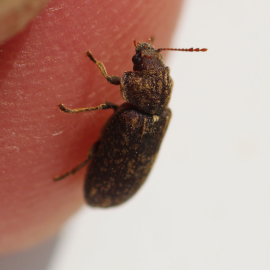A close-up on HMS Victory’s smallest inhabitants: The deathwatch beetle
- View news filtered by: 21st Century
- View news filtered by: Napoleonic
- View news filtered by: Ships and Aircraft
- View news filtered by: HMS Victory
- View news filtered by type: Blog

One of the biggest jobs in the conservation of HMS Victory concerns its smallest inhabitant. The conservation team at the National Museum of the Royal Navy, including Cathryn Harvey a PhD researcher from Cranfield University, are battling an infestation of deathwatch beetle onboard HMS Victory. This infestation was first officially discovered in 1932, and its destructive capabilities were well known. But why is this beetle, less than a centimetre long, such a threat? And where does its ominous name come from?
The deathwatch beetle is a woodboring insect with a lifespan of up to 13 years. It lays its eggs in wood and the larvae, upon hatching, then burrow further. This criss-crossing of tunnels can threaten the integrity of the wood itself. Interestingly it is also known for its preference for hardwood, and especially oak. This is a major problem in the UK where many historic structures, including HMS Victory, are built from oak. The identifying feature of the deathwatch beetle is its ability to make tapping sounds, which are created by bumping its head into the wood it’s burrowing into.
An explanation of where the deathwatch beetle got its menacing name can be seen from none other than Mark Twain. In the Adventures of Tom Sawyer, Twain describes how “the ghastly ticking of a death-watch in the wall at the bed’s head made Tom shudder—it meant that somebody’s days were numbered.” Historically the deathwatch beetle’s tapping sound would’ve only been heard in the dead of night and alongside silent vigils for dying loved ones. The deathwatch beetle became an omen for an imminent death. The beetle was used for a similar reason in Edgar Allan Poe’s The Tell-Tale Heart, where the narrator hears them in his walls, while his sanity is questioned throughout the story. In reality this tapping is for a less scary reason, it’s a mating call to attract a mate so it can reproduce and lay eggs.
There have been many examples where deathwatch beetles have caused significant damage to historic buildings, most notably at Westminster Hall in the 1910s. Deathwatch beetles had caused so much damage to the building that there was a risk of the entire roof caving in. This was prevented with pesticides and chemical treatments, but the damage to the wood from the beetle meant that some cavities were so large that an adult could hide in them.
In nature the deathwatch beetle has a less destructive purpose, breaking down rotten trees in forests, creating the chance for new trees to thrive. In the modern world rotten trees are often cleared away quickly leaving them with the problem of finding a substitute. To the deathwatch beetle there is little difference between Vice Admiral Lord Nelson’s flagship and a rotting oak tree, both are dense pieces of wood that are no longer growing, the difference is one isn’t moving anytime soon.
The work around the deathwatch beetle is but one part of the decade-long plan to conserve HMS Victory, fighting to protect her for future generations. To find out more about this project please visit the Victory Hub. Alternatively, you can read more about deathwatch beetles in relation to HMS Victory specifically.
HMS Victory remains open at Portsmouth Historic Dockyard, alongside Victory Live: The Big Repair which allows visitors to venture onto the scaffold to see the conservation of Victory in action. A ticket to HMS Victory includes access to Victory Live: The Big Repair and the HMS Victory Gallery.
image credit: Galerie du Monde des insectes